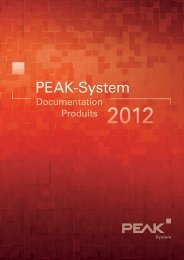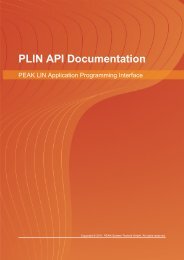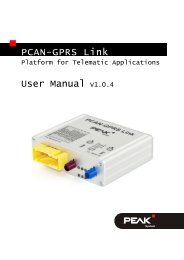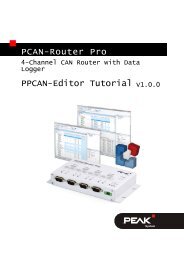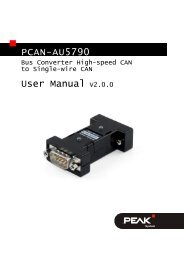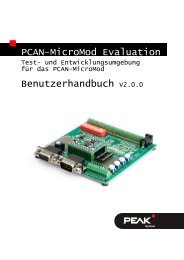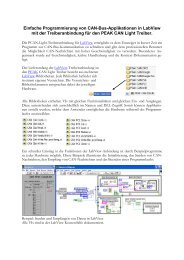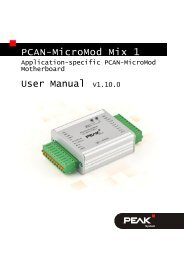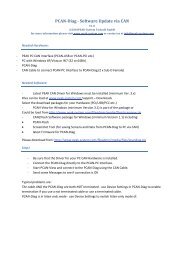PCAN Basic API for LabVIEW 2009 - PEAK-System
PCAN Basic API for LabVIEW 2009 - PEAK-System
PCAN Basic API for LabVIEW 2009 - PEAK-System
Create successful ePaper yourself
Turn your PDF publications into a flip-book with our unique Google optimized e-Paper software.
<strong>PCAN</strong> <strong>Basic</strong> <strong>API</strong> <strong>for</strong> <strong>LabVIEW</strong> <strong>2009</strong><br />
Purpose and scope: Design of an easy to use <strong>LabVIEW</strong> <strong>API</strong> <strong>for</strong> the<br />
<strong>PCAN</strong>-<strong>Basic</strong> Interface DLL.<br />
Examples folder:<br />
Two examples are included to demonstrate how to<br />
send and receive CAN messages.<br />
Controls folder:<br />
Some strict typed def. ENUM- and cluster-controls are<br />
defined to simplify usage. They are all created<br />
according to the <strong>PCAN</strong> <strong>API</strong> description.<br />
Get and Set Value Vis are stored in separated<br />
directories while there functionalities of input / output<br />
values are different according to the requested / set<br />
value. For easy usage they are combined into two<br />
polymorphic Vis called 'CAN Get Value.vi' and 'CAN<br />
Set Value.vi'<br />
The top level Vis are shown on the left hand side:<br />
Each and every Vi has a context help <strong>for</strong> the purpose,<br />
usage, and return values.
All Vis and controls reside within the <strong>LabVIEW</strong> User.lib<br />
Access the <strong>PCAN</strong>-<strong>Basic</strong> controls by opening the user lib from the front panel.<br />
Access the <strong>PCAN</strong> <strong>Basic</strong> Vis by opening the user lib from the block diagram.<br />
Top level Vis are accessible from here. Vis <strong>for</strong> set and get value are separated into sub<br />
pallets due to the fact that they are not needed very often while two polymorphic top level<br />
Vis are available to call these Vis.<br />
Additionally there is a sub pallet available <strong>for</strong> the example Vis. The examples are created<br />
to demonstrate how to receive and send data using the <strong>API</strong>.<br />
Receive data example:<br />
On the left hand side are the input variables<br />
like 'release all channels first' up to BTR0BTR1<br />
listed. Outputs are CAN Data array and CAN<br />
Timestamp array.
The block diagram illustrates the <strong>API</strong> usage. The inner loop, on the right hand side, is<br />
ended if an error occurs or the receive queue is empty. Receive queue empty is not an<br />
error and will be suppressed by CAN READ. While receive queue empty doesn't lead to<br />
an abort of the loop the occurrence of an real existing error will stop the program. In this<br />
case the user has to decide what to do if an error occurs. The example just demonstrates<br />
what could be and not what should be done.<br />
Send Data example:<br />
On the left hand side the input controls are listed while on<br />
the right hand side the send data cluster is visible.


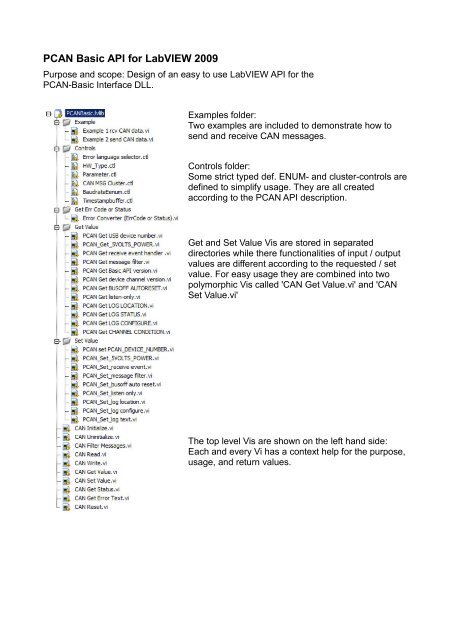
![English - Low Quality [7.2 MB] - PEAK-System](https://img.yumpu.com/5931738/1/184x260/english-low-quality-72-mb-peak-system.jpg?quality=85)
